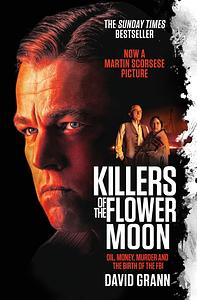Take a photo of a barcode or cover
14.5k reviews for:
Killers of the Flower Moon: The Osage Murders and the Birth of the FBI
David Grann
14.5k reviews for:
Killers of the Flower Moon: The Osage Murders and the Birth of the FBI
David Grann
dark
informative
sad
medium-paced
I didn't know anything about the Osage going into this book. Really shocking, and it's a shame this isn't something most of us learn about in school.
Writing style was really challenging for me to get into. At times, I had a hard time following who was who.
Writing style was really challenging for me to get into. At times, I had a hard time following who was who.
emotional
informative
reflective
fast-paced
informative
mysterious
tense
medium-paced
dark
emotional
informative
mysterious
reflective
sad
tense
fast-paced
challenging
dark
mysterious
tense
fast-paced
This is narrative non-fiction at its best. Granny immediately invests you in the story and manages to keep you on the edge of your seat while never letting you forget that these are real people. The writing is compulsive and filled with pathos, balancing description and firsthand reports & transcripts with an immersive quality that is never sensationalist but moves in that direction. This almost reads like a true crime story, but what is critical is that the reader never feels like we are profiting off of others’ suffering, and the trauma these many people lived, and still are living, is not made into spectacle or entertainment.
The structure of the book is effective as well. The first part tells the intimate story of the murders, the second part tells the story of the law investigating (or not) those murders, and the final section, which is what makes this book special, is written in the first person regarding what other information Grann uncovered while doing this research. It maintains a narrative flair, and he meets with living relatives of the people who were central to the first part of the book. On one hand, this section moves out of narrative storytelling and tells a more expansive, traditional history. Yet on the other hand he insists on telling this in the first-person, making it not just about the people but on his search for the truth of what happened to those people. I really appreciate the way this makes it abundantly clear that the historian cannot be absent from the history. I also appreciate that it effectively removes this story out of the realm of history and brings it to the present, to something still happening, now.
I wish I could say I finished the book and felt good, but it is kind of the opposite. What he uncovers in the course of his research is not in any way heart-warming or reassuring. However, it is an important part of the story of America, one that we would do well not to look away from, painful as it may be. So, no, I didn’t feel good at the conclusion of this book, but I am appreciative for the sunlight Grann brings to our history and feel like it is important knowledge.
challenging
dark
sad
fast-paced
dark
mysterious
sad
tense
slow-paced
medium-paced
What a heartbreaking story. Ever since reading The Lost City of Z, I was on the David Grann hype train. He writes in the style of Erik Larson, taking true crime and crafting it into a compelling story.
Killers of the Flower Moon details two concurrent stories: a murderous spree in the 1920's targeting the wealthy Osage tribe in Oklahoma and the rise of a nascent law enforcement agency that would come to be known as the Federal Bureau of Investigation.
After being forced from their ancestral lands to a reservation in Oklahoma, the Osage Principal Chief James Bigheart negotiated with the federal government to retain mineral rights. This would prove lucrative for the Osage nation, as each member now had an ownership stake in the massive oil deposit that would be discovered beneath the land they were forced to call home. Before white guardians swooped in with schemes to cash in on the federal government's refusal to recognize Osage citizenship, tribe members were receiving up to $12,000 per year in oil rights. Many Osage members drove the fanciest cars, kept white servants, and experienced a wealth they'd never dreamed of.
Then in the early 1920's, the Osage experienced what is now referred to as the "Reign of Terror." Over 60 wealthy Osage were murdered between the years of 1920 - 1925, with many estimates ranging much higher. Osage were poisoned, murdered, and shot to death by local whites in an attempt to cash in on their mineral headrights. Grann's book uncovers a widespread conspiracy to rob the Osage of their wealth involving local law enforcement, businessmen, and even those who'd married into the Osage nation.
Around the time of the murders, the FBI was in its infancy and just starting to take shape around J. Edgar Hoover. Grann's book details the team that was sent to investigate the Reign of Terror and how they uncovered a plot so nefarious that you'd think it was plucked from a novel.
The heartbreaking part is that many Osage family members never received any closure, due to the judicial system's apathy towards investigation and/or prosecution of those who perpetrated the Reign of Terror. This is a dark time that isn't that far removed from many Osage living today. Grann interviews grandchildren and great-grandchildren of Osage who's family were either present during the Reign of Terror or were targets at the time. It is an open wound that has never really healed.
And while some murderers were found and prosecuted, many got rich off the Osage and never faced justice. Based on Grann's reserach, the FBI was all too aware the murderous conspiracy extended beyond their suspects but never pursued other leads. It's a tale of terrorism and an utter failure by law enforcement.
With Grann's eye, the story is laid out both sympathetic and methodical. He goes into great detail to show how the killers might've committed their heinous acts and why the FBI probably missed many more murders that never got investigated. As far as I'm concerned as a reader, Grann is 2-for-2. A compelling read from both sides, Killers of the Flower Moon is a somewhat forgotten piece of American History that gets its due spotlight.
Killers of the Flower Moon details two concurrent stories: a murderous spree in the 1920's targeting the wealthy Osage tribe in Oklahoma and the rise of a nascent law enforcement agency that would come to be known as the Federal Bureau of Investigation.
After being forced from their ancestral lands to a reservation in Oklahoma, the Osage Principal Chief James Bigheart negotiated with the federal government to retain mineral rights. This would prove lucrative for the Osage nation, as each member now had an ownership stake in the massive oil deposit that would be discovered beneath the land they were forced to call home. Before white guardians swooped in with schemes to cash in on the federal government's refusal to recognize Osage citizenship, tribe members were receiving up to $12,000 per year in oil rights. Many Osage members drove the fanciest cars, kept white servants, and experienced a wealth they'd never dreamed of.
Then in the early 1920's, the Osage experienced what is now referred to as the "Reign of Terror." Over 60 wealthy Osage were murdered between the years of 1920 - 1925, with many estimates ranging much higher. Osage were poisoned, murdered, and shot to death by local whites in an attempt to cash in on their mineral headrights. Grann's book uncovers a widespread conspiracy to rob the Osage of their wealth involving local law enforcement, businessmen, and even those who'd married into the Osage nation.
Around the time of the murders, the FBI was in its infancy and just starting to take shape around J. Edgar Hoover. Grann's book details the team that was sent to investigate the Reign of Terror and how they uncovered a plot so nefarious that you'd think it was plucked from a novel.
The heartbreaking part is that many Osage family members never received any closure, due to the judicial system's apathy towards investigation and/or prosecution of those who perpetrated the Reign of Terror. This is a dark time that isn't that far removed from many Osage living today. Grann interviews grandchildren and great-grandchildren of Osage who's family were either present during the Reign of Terror or were targets at the time. It is an open wound that has never really healed.
And while some murderers were found and prosecuted, many got rich off the Osage and never faced justice. Based on Grann's reserach, the FBI was all too aware the murderous conspiracy extended beyond their suspects but never pursued other leads. It's a tale of terrorism and an utter failure by law enforcement.
With Grann's eye, the story is laid out both sympathetic and methodical. He goes into great detail to show how the killers might've committed their heinous acts and why the FBI probably missed many more murders that never got investigated. As far as I'm concerned as a reader, Grann is 2-for-2. A compelling read from both sides, Killers of the Flower Moon is a somewhat forgotten piece of American History that gets its due spotlight.
I am glad they point out it wasnt just this family and there were likely many other murders uninvestigated. But I do think this was a little bit too about Tom White and needed to be more about Osage and not just the white people in the town.



